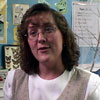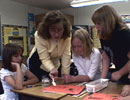Join us for conversations that inspire, recognize, and encourage innovation and best practices in the education profession.
Available on Apple Podcasts, Spotify, Google Podcasts, and more.
 “Science is just about my students’ favorite subject now, and honestly, years ago when I was teaching, I wouldn’t say that was true–you know, there wasn’t as much excitement by the kids when you started a new unit. But with the actual exploring built into the curriculum, all the things they do themselves, it gets them excited, and that’s a big part of what’s fun about teaching science.”
“Science is just about my students’ favorite subject now, and honestly, years ago when I was teaching, I wouldn’t say that was true–you know, there wasn’t as much excitement by the kids when you started a new unit. But with the actual exploring built into the curriculum, all the things they do themselves, it gets them excited, and that’s a big part of what’s fun about teaching science.”
Mary Bitterlich teaches third grade at Glennon Heights Elementary School in Lakewood, CO, a suburb of Denver west of the city, toward the mountains. Lakewood is a quiet middle-class community that has watched the population in the Denver area explode during the past thirty years. Founded in 1958, the school has seen what was once a sparsely built stretch of land between Denver and the mountains fill in with young communities full of new homes.
About 25% of the school’s 270 children are from minority populations. Glennon Heights’ students’ state test scores tend to be consistent with or higher than state averages.
Mary credits her children’s interest in science to the hands-on nature of the subject, and she has noticed that her school’s new curriculum, the Biological Sciences Curriculum Study’s (B.S.C.S.) Science T.R.A.C.S. (Teaching Relevant Activities for Concepts and Skills), does a good job encouraging children to explore and use their hands and minds. She feels it has made a big difference: “Not only is that a great way for the kids to learn, but it’s also a fun way to teach the kids, because they’re so involved, so motivated, so engaged…Science is their favorite subject now, and years ago, I wouldn’t say that was true.” Life science especially appeals to them, said Mary, because of the many ways they can connect to the subject matter.
 Lesson at a Glance:
Lesson at a Glance:
Curriculum: Science T.R.A.C.S. (Teaching Relevant Activities for Concepts and Skills), Biological Sciences Curriculum Study, Kendall/Hunt Publishing Company
Grade: Third
Topic: Life Cycles
Prior to the activity featured in the video for Session 3, Mary worked with her class on life cycles. In the unit’s first activity, she gave her students pictures of animals or plants and asked them to answer the question: “What was it before?” Without any other guidance, the students worked in small groups and drew what they thought represented an earlier stage of each plant and animal’s life. “A lot were accurate, a lot not totally accurate, and in some cases they were totally wrong,” said Mary.
In the next activity, Mary presented her class with a jar containing several objects and asked them to sort the contents. Inside were adults, larvae (mealworms), and pupae of the darkling beetle. Working in small groups and then as a class, the students decided that the objects were “beetles,” “worms,” and “some dead stuff,” with the pupae being the dead stuff. She then gave each group three empty baby food jars and had them sort the objects for further observation.
The class monitored the jars over the next several days. Soon the pupae matured into beetles, causing Mary’s students to decide that the “dead stuff” was actually “beetle eggs.” Then the mealworms were observed to develop into pupae. “The kids just exploded with thoughts,” said Mary, “and then we probably had a good 30-45 minute talk as a class and in small groups…the groups came back together and presented their findings. And in that talk, they discovered the life cycle for themselves.”
To synthesize their ideas, Mary gave each of her students a paper plate and a piece of paper with pictures of an egg, larva, pupa, and an adult beetle on it. The students were to cut out the pictures, label them, and place them clockwise on the plate in the order of a beetle’s life cycle. At the end, in an effort to give her students a notion of the life cycle as a series of successive generations of individual beetle’s lives, she had her students put their plates together, making the class’s life cycle model a spiral rather than a simple circle.
 Lesson Goals:
Lesson Goals:
Consider the goals for this lesson as listed above. How can you create a lesson appropriate for your students that will fulfill similar goals?